- Home
- Semester and Timetable Information
- Study Physics
- Our Research
- Our People
- Careers and Alumni
- Seminars, News and Events
- Outreach and School Resources
- About the School
- What is Physics
- The Crawford Observatory
- Frequently Asked Questions
- UCC Futures Quantum & Photonics
- Supports
Seminars 2022/2023
Muhammad Sirajul Hasan 15th May 2023
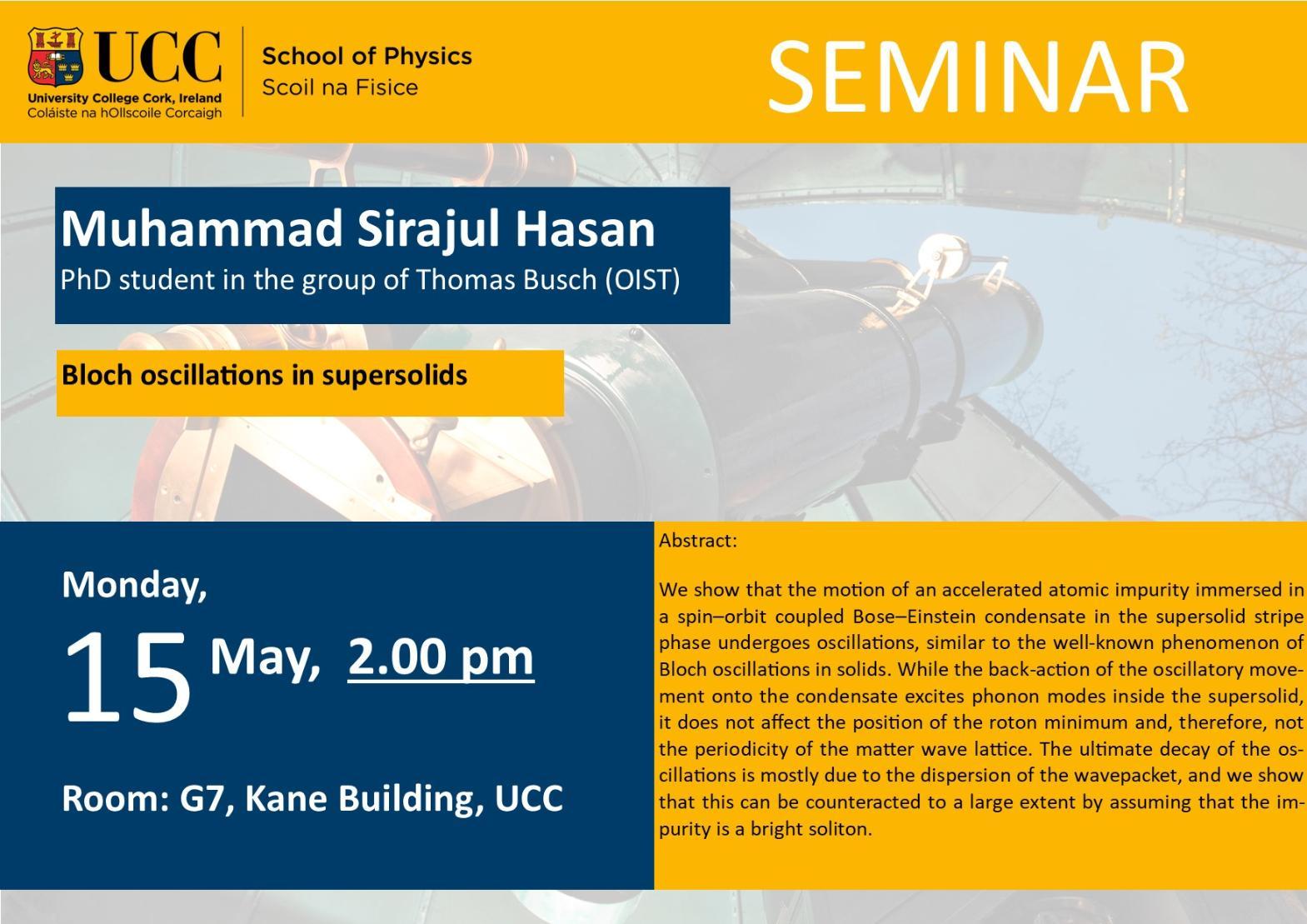
| Seminar Speaker: | Muhammad Sirajul Hasan PhD student in the group of Thomas Busch (OIST) and he is currently visiting UCC for 3 months |
|---|---|
| Venue: |
G7, Kane Building, UCC |
| Time and Date: | Monday, 15th, May, 2023 2pm |
| Title: | Bloch oscillations in supersolids |
| Overview: We show that the motion of an accelerated atomic impurity immersed in a spin–orbit coupled Bose–Einstein condensate in the supersolid stripe phase undergoes oscillations, similar to the well-known phenomenon of Bloch oscillations in solids. While the back-action of the oscillatory movement onto the condensate excites phonon modes inside the supersolid, it does not affect the position of the roton minimum and, therefore, not the periodicity of the matter wave lattice. The ultimate decay of the oscillations is mostly due to the dispersion of the wavepacket, and we show that this can be counteracted to a large extent by assuming that the impurity is a bright soliton.
|
|---|
Paul O'Connor, March 13th, 2023
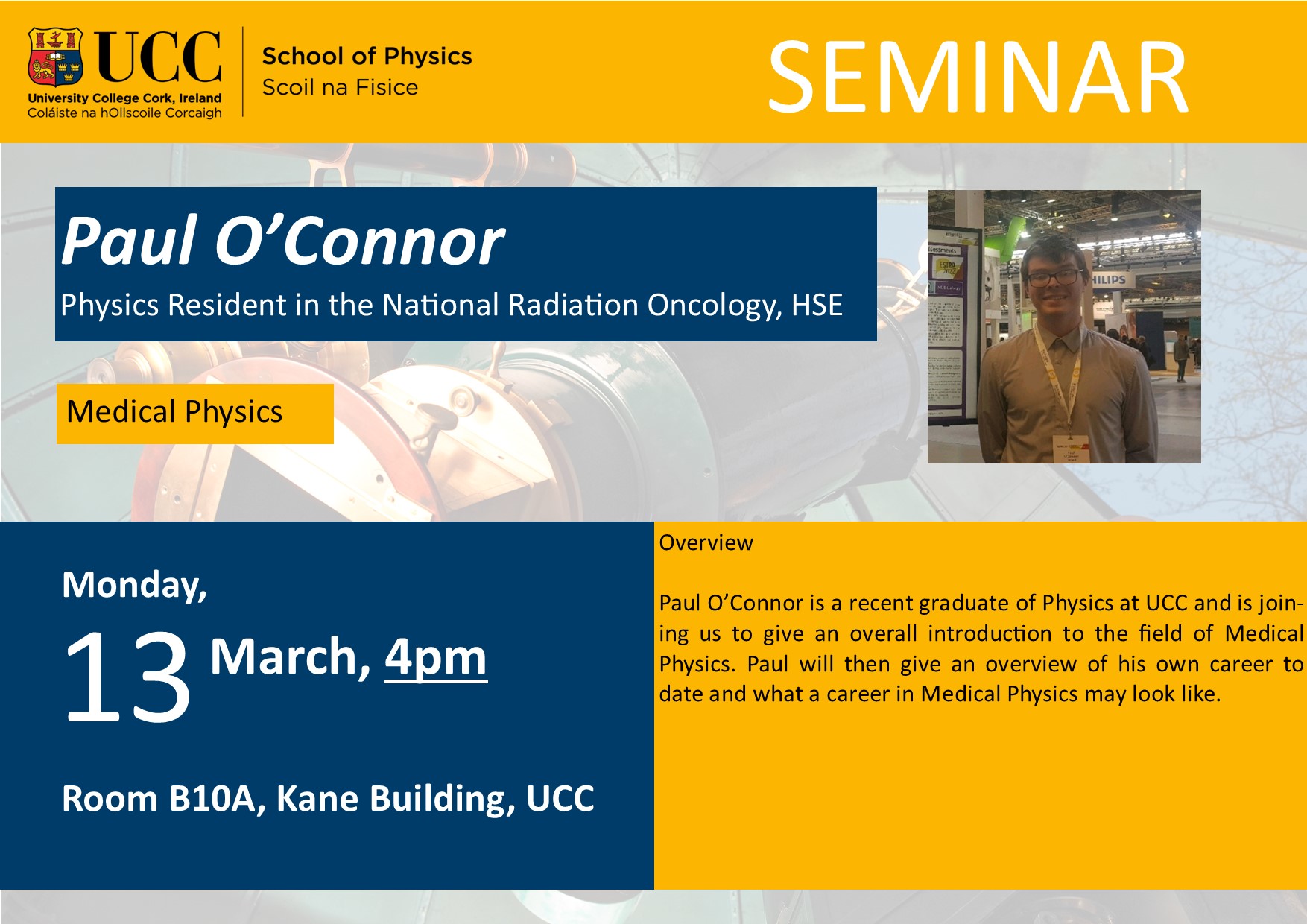
| Seminar Speaker: | Paul O'Connor |
|---|---|
| Venue: |
B10A, Kane Building, UCC |
| Time and Date: | Monday, 13th March, 2023 4pm |
| Title: | Medical Physics |
| Overview: Paul O’Connor is a recent graduate of Physics at UCC and is joining us to give an overall introduction to the field of Medical Physics. Paul will then give an overview of his own career to date and what a career in Medical Physics may look like.
|
|---|
Donna Rodgers-Lee, March 6th 2023
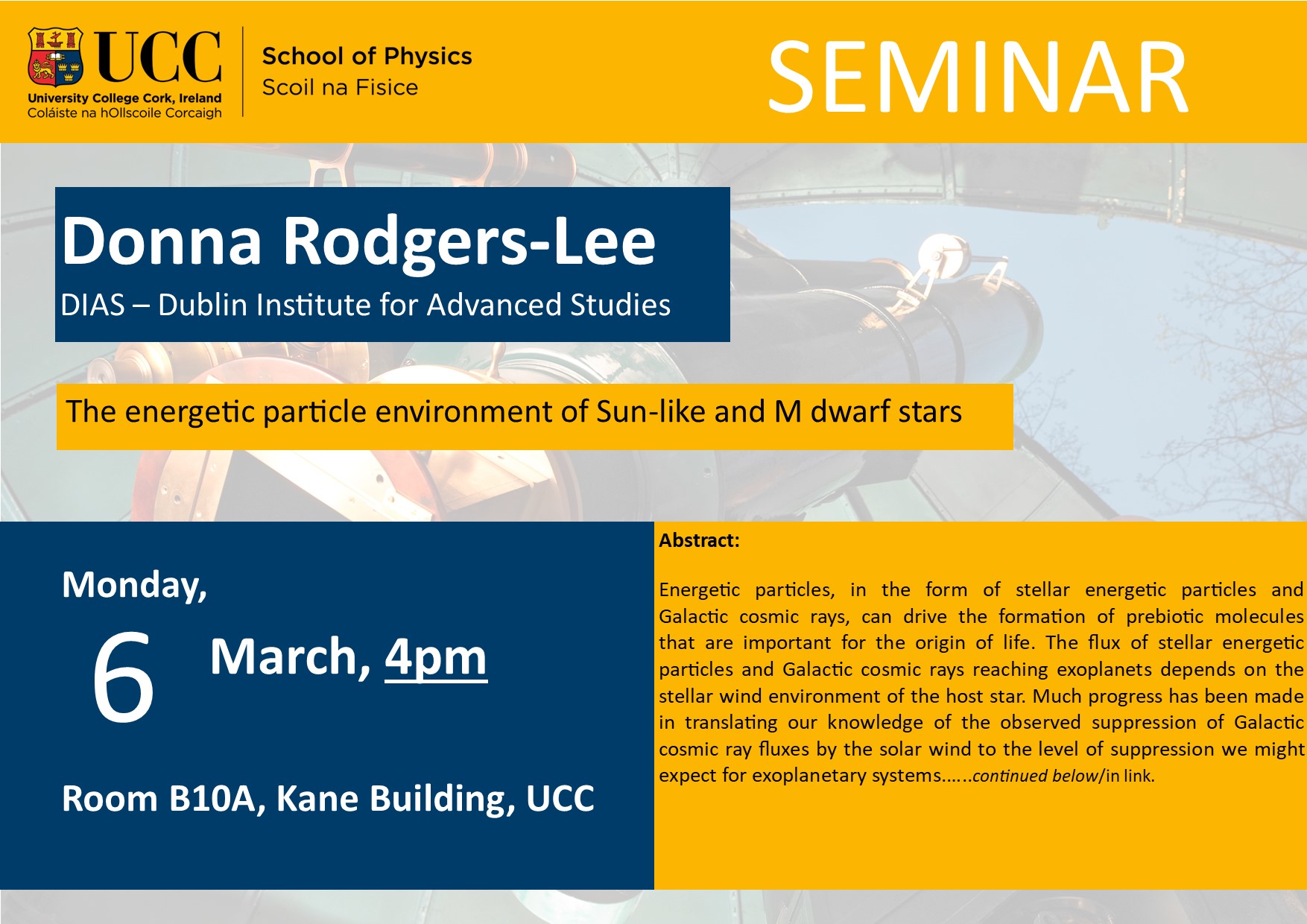
| Seminar Speaker: | Donna Rodgers-Lee |
|---|---|
| Venue: |
B10A, Kane Building, UCC |
| Time and Date: | Monday, 6th March, 2023 4pm |
| Title: | The energetic particle environment of Sun-like and M dwarf stars |
| Abstract: Energetic particles, in the form of stellar energetic particles and |
|---|
Adrian Podoleanu, 30th January 2023
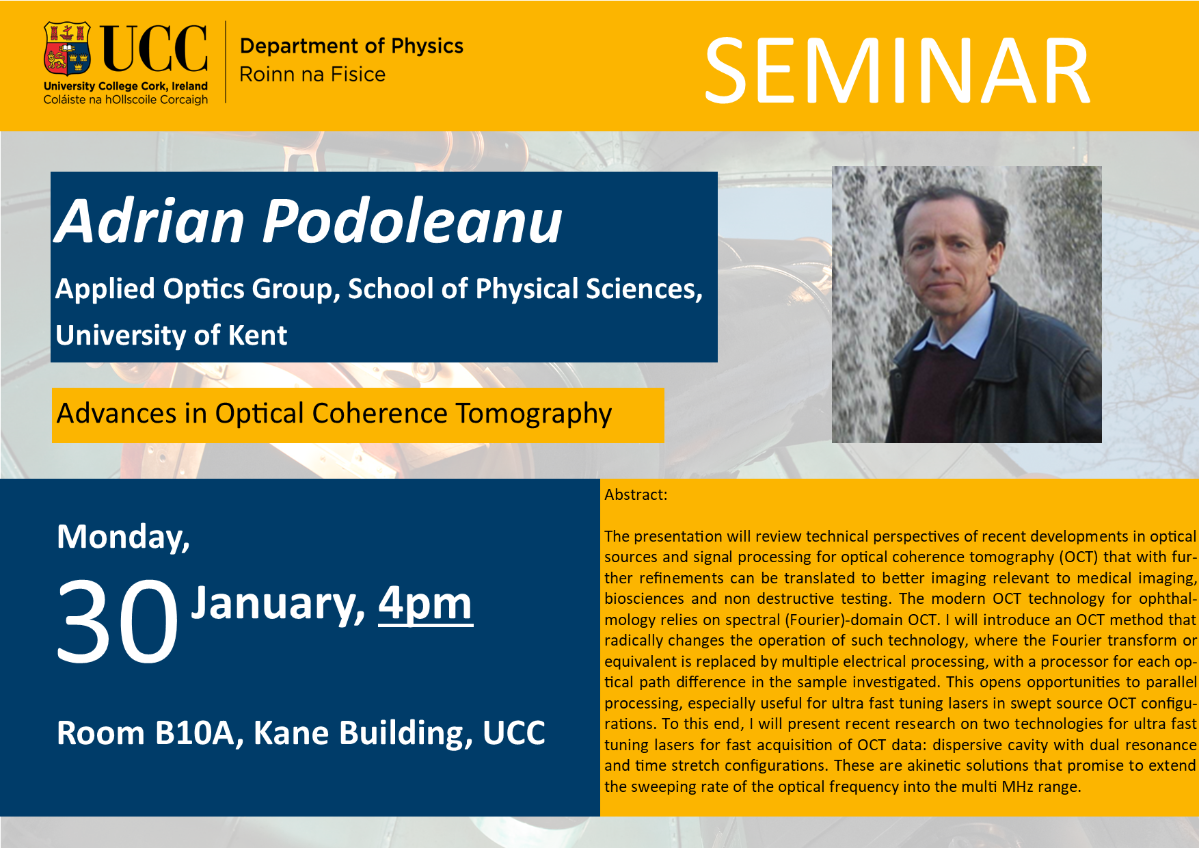
| Seminar Speaker: | Adrian Podoleanu, Head of the Applied Optics Group, Professor of Biomedical Optics in the School of Physical Sciences, University of Kent, Canterbury, UK |
|---|---|
| Venue: |
B10A, Kane Building, UCC |
| Time and Date: | Monday, 30th December, 2023 4pm |
| Title: | Advances in Optical Coherence Tomography |
| Abstract: The presentation will review technical perspectives of recent developments in optical sources and signal processing for optical coherence tomography (OCT) that with further refinements can be translated to better imaging relevant to medical imaging, biosciences and non destructive testing. The modern OCT technology for ophthalmology relies on spectral (Fourier)-domain OCT. I will introduce an OCT method that radically changes the operation of such technology, where the Fourier transform or equivalent is replaced by multiple electrical processing, with a processor for each optical path difference in the sample investigated. This opens opportunities to parallel processing, especially useful for ultra fast tuning lasers in swept source OCT configurations. To this end, I will present recent research on two technologies for ultra fast tuning lasers for fast acquisition of OCT data: dispersive cavity with dual resonance and time stretch configurations. These are akinetic solutions that promise to extend the sweeping rate of the optical frequency into the multi MHz range. |
|---|
Vik Dhillon, 21st November 2022
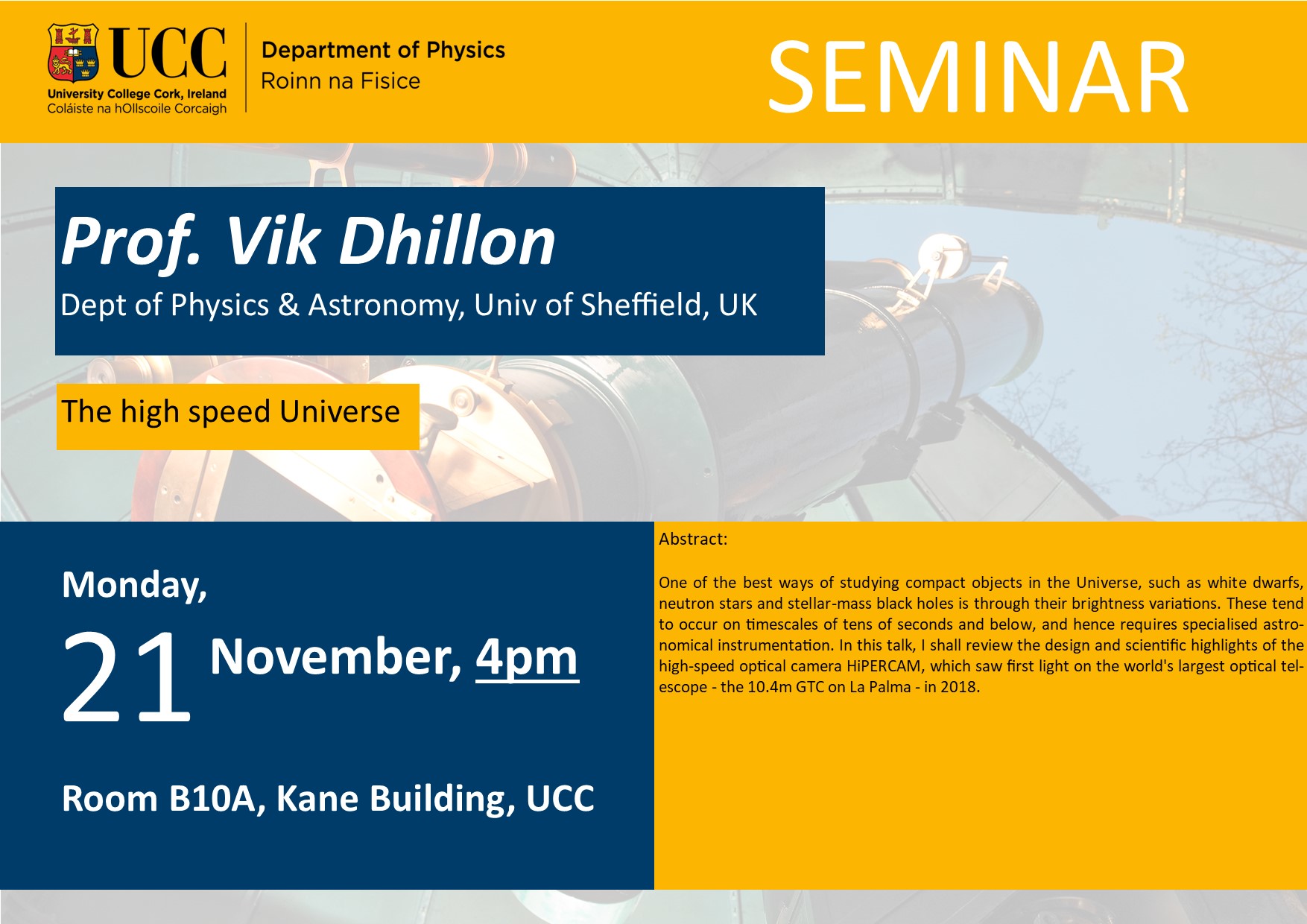
| Seminar Speaker: | Prof. Vik Dhillon, Dept of Physics & Astronomy, Univ of Sheffield, UK |
|---|---|
| Venue: |
B10A, Kane Building, UCC |
| Time and Date: | Monday, 21st November, 2022 4pm |
| Title: | The high speed Universe |
| Abstract: One of the best ways of studying compact objects in the Universe, such as white dwarfs, neutron stars and stellar-mass black holes is through their brightness variations. These tend to occur on timescales of tens of seconds and below, and hence requires specialised astronomical instrumentation. In this talk, I shall review the design and scientific highlights of the high-speed optical camera HiPERCAM, which saw first light on the world's largest optical telescope - the 10.4m GTC on La Palma - in 2018. |
|---|
Cillian O'Driscoll, 14th November 2022
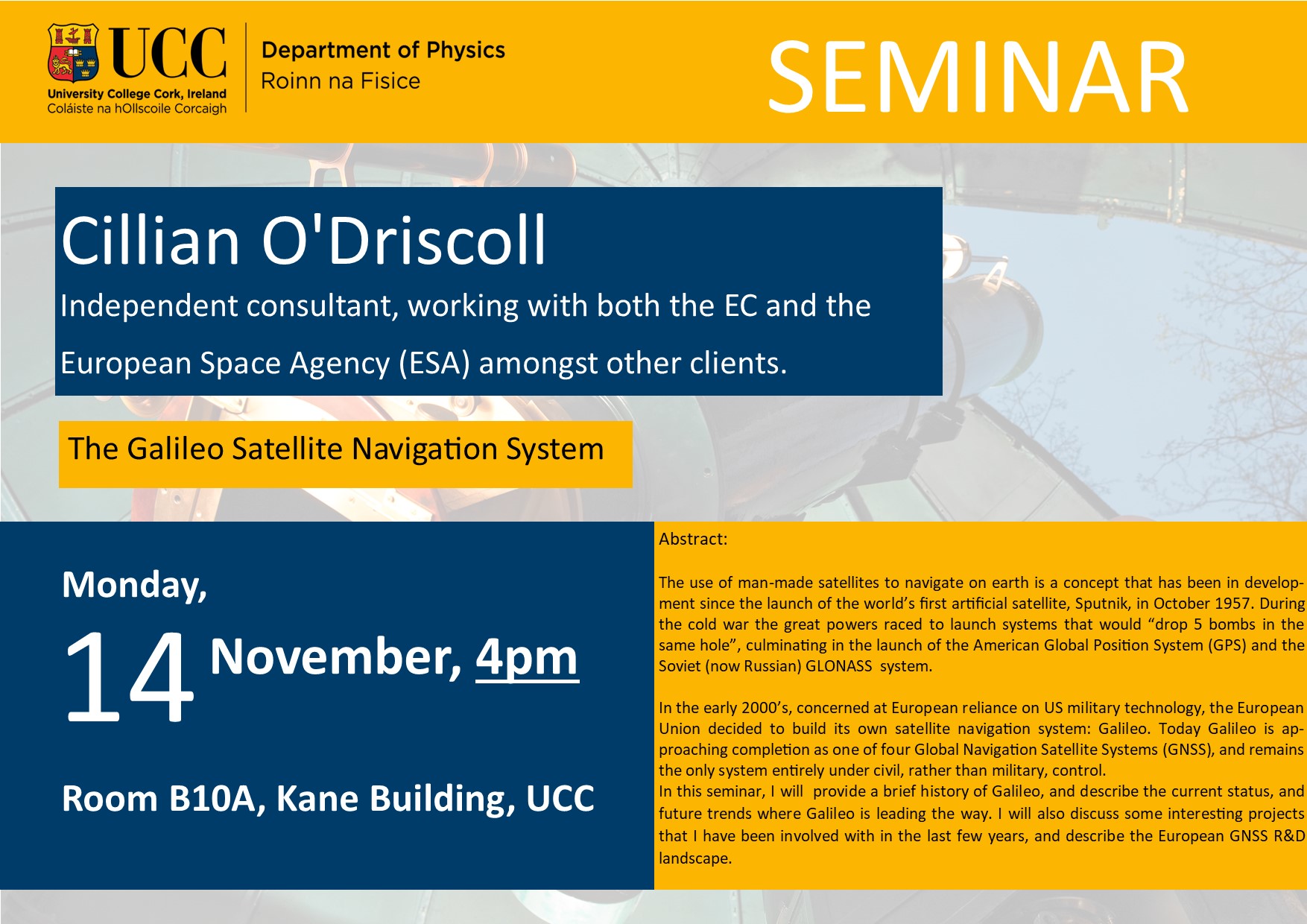
| Seminar Speaker: | Cillian O'Driscoll Cillian O’Driscoll holds a PhD in Electrical and Electronic Engineering from UCC. He has been active in satellite navigation research and development since 2001, with more than 70 publications in international conferences and journals. He previously worked as a research engineer in the University of Calgary, Canada, and with the European Commission contributing to the EU satellite navigation system Galileo. He is currently an independent consultant, working with both the EC and the European Space Agency (ESA) amongst other clients. |
|---|---|
| Venue: |
B10A, Kane Building, UCC |
| Time and Date: | Monday, 14th November, 2022 4pm |
| Title: | The Galileo Satellite Navigation System |
| Abstract: The use of man-made satellites to navigate on earth is a concept that has been in development since the launch of the world’s first artificial satellite, Sputnik, in October 1957. During the cold war the great powers raced to launch systems that would “drop 5 bombs in the same hole”, culminating in the launch of the American Global Position System (GPS) and the Soviet (now Russian) GLONASS system. In the early 2000’s, concerned at European reliance on US military technology, the European Union decided to build its own satellite navigation system: Galileo. Today Galileo is approaching completion as one of four Global Navigation Satellite Systems (GNSS), and remains the only system entirely under civil, rather than military, control. In this seminar, I will provide a brief history of Galileo, and describe the current status, and future trends where Galileo is leading the way. I will also discuss some interesting projects that I have been involved with in the last few years, and describe the European GNSS R&D landscape. |
|---|
Bruno Romeira 24 October 2022
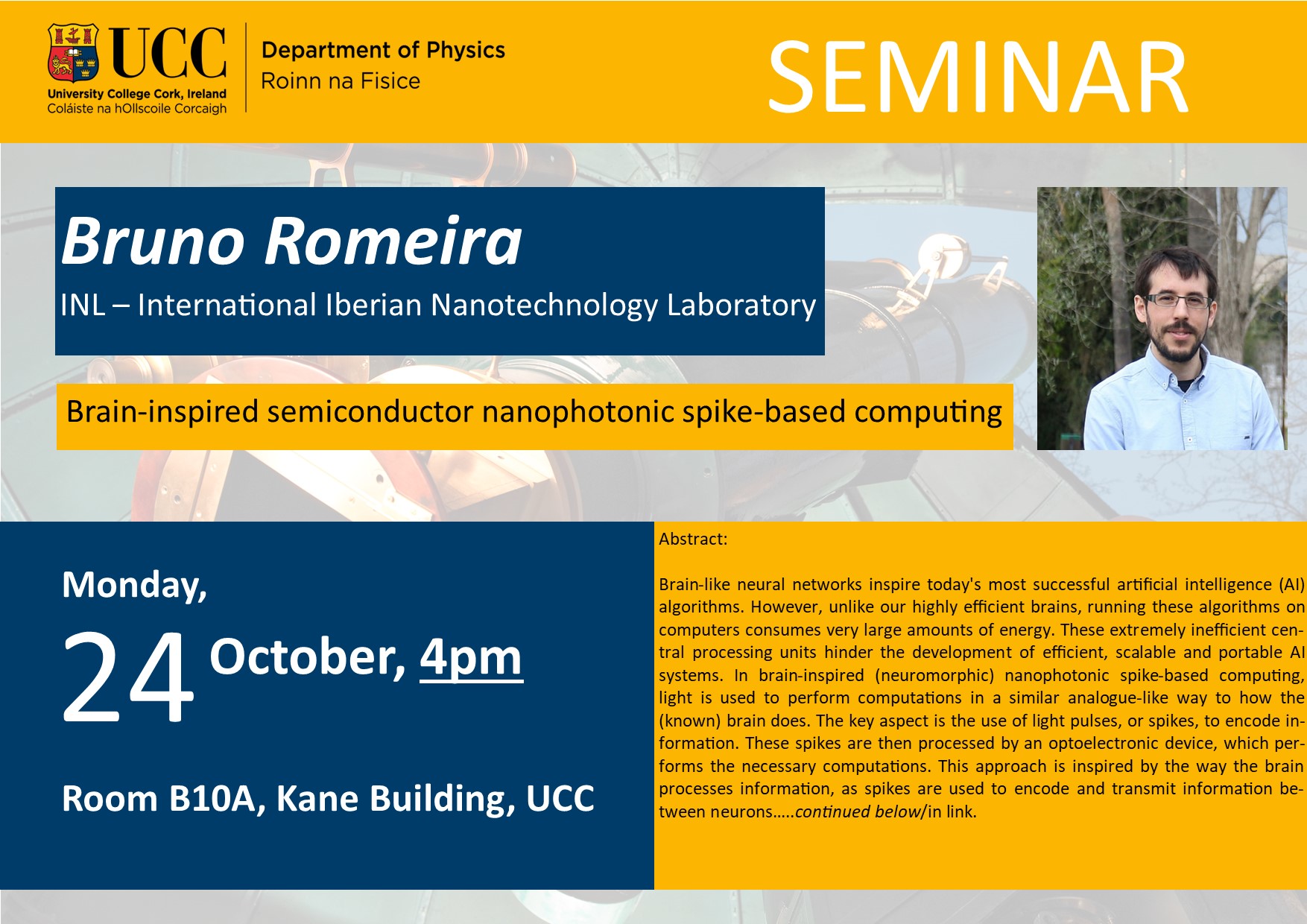
| Seminar Speaker: | Bruno Romeira |
|---|---|
| Venue: |
B10A, Kane Building, UCC |
| Time and Date: | Monday, 24th October, 2022 4pm |
| Title: | Brain-inspired semiconductor nanophotonic spike-based computing |
| Abstract: Brain-like neural networks inspire today's most successful artificial intelligence (AI) algorithms. However, unlike our highly efficient brains, running these algorithms on computers consumes very large amounts of energy. These extremely inefficient central processing units hinder the development of efficient, scalable and portable AI systems. In brain-inspired (neuromorphic) nanophotonic spike-based computing, light is used to perform computations in a similar analogue-like way to how the (known) brain does. The key aspect is the use of light pulses, or spikes, to encode information. These spikes are then processed by an optoelectronic device, which performs the necessary computations. This approach is inspired by the way the brain processes information, as spikes are used to encode and transmit information between neurons. In this seminar, I will explore the possibility of subwavelength photonics nanotechnology to provide the compact, high-bandwidth, and energy-efficient central processing spiking nodes required to build a future brain-like light-based computing architecture. I will specifically discuss how semiconductor quantum technologies (resonant tunneling nanostructures) embedded in subwavelength nanoLEDs, nanolasers, and nanophotodetectors, which are 100 times smaller than conventional optoelectronic light sources and photodetectors, can efficiently confine, emit, detect, and process neuron-like light spikes. Lastly, I will discuss strategies for interconnecting these emitter-receiver spiking photonic neural nodes using 3D optical interconnections. Future progress in spike-based photonic nanocircuits will pave the way for efficient neuromorphic optical computing with the potential to transform numerous fields ranging from medicine to finance, robotics and AI. |
|---|
Rayhane Ghane, ficonTEC, 17th October 2022
![]()
| Seminar Speaker: | Rayhane Ghane, ficonTEC |
|---|---|
| Venue: |
B10A, Kane Building, UCC |
| Time and Date: | Monday, 17th October, 2022 4pm |
| Title: |
ficonTEC photonics assembly and testing |
| Abstract: I am going to start my presentation with an introduction to photonics packaging. Then, I will talk about automated systems for photonics assembly and testing. Afterwards, I will introduce ficonTEC solutions. |
|---|
Kieran Cleary, 21st September, 2022
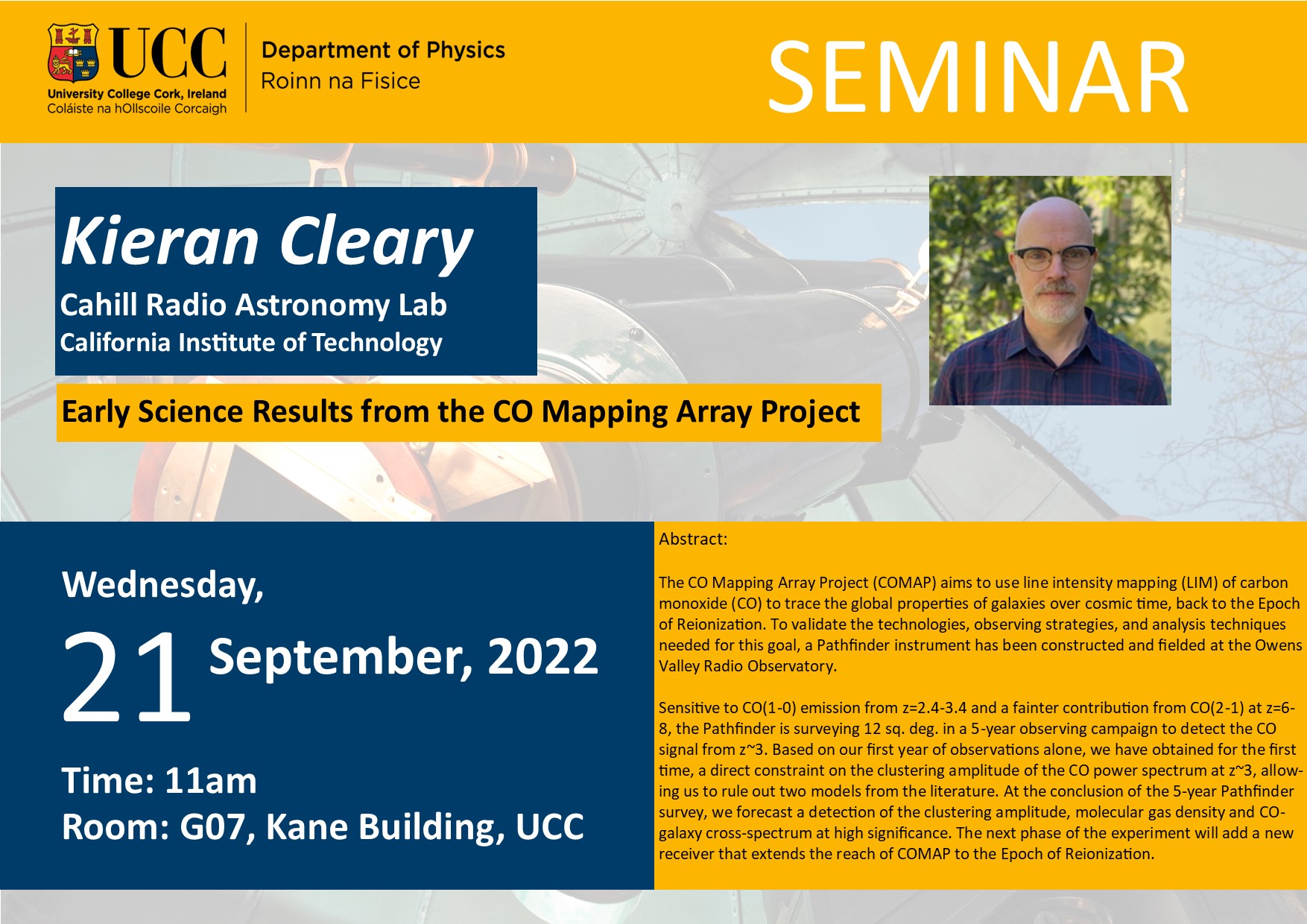
| Seminar Speaker: | Kieran Cleary |
|---|---|
| Venue: |
G07, Kane Building, UCC |
| Time and Date: | Wednesday, 21st September, 2022 11am |
| Title: |
Early Science Results from the CO Mapping Array Project |
| Abstract: The CO Mapping Array Project (COMAP) aims to use line intensity mapping (LIM) of carbon monoxide (CO) to trace the global properties of galaxies over cosmic time, back to the Epoch of Reionization. To validate the technologies, observing strategies, and analysis techniques needed for this goal, a Pathfinder instrument has been constructed and fielded at the Owens Valley Radio Observatory. Sensitive to CO(1-0) emission from z=2.4-3.4 and a fainter contribution from CO(2-1) at z=6-8, the Pathfinder is surveying 12 sq. deg. in a 5-year observing campaign to detect the CO signal from z~3. Based on our first year of observations alone, we have obtained for the first time, a direct constraint on the clustering amplitude of the CO power spectrum at z~3, allowing us to rule out two models from the literature. At the conclusion of the 5-year Pathfinder survey, we forecast a detection of the clustering amplitude, molecular gas density and CO-galaxy cross-spectrum at high significance. The next phase of the experiment will add a new receiver that extends the reach of COMAP to the Epoch of Reionization.
|
|---|
Jerry Moloney, 12th September, 2022
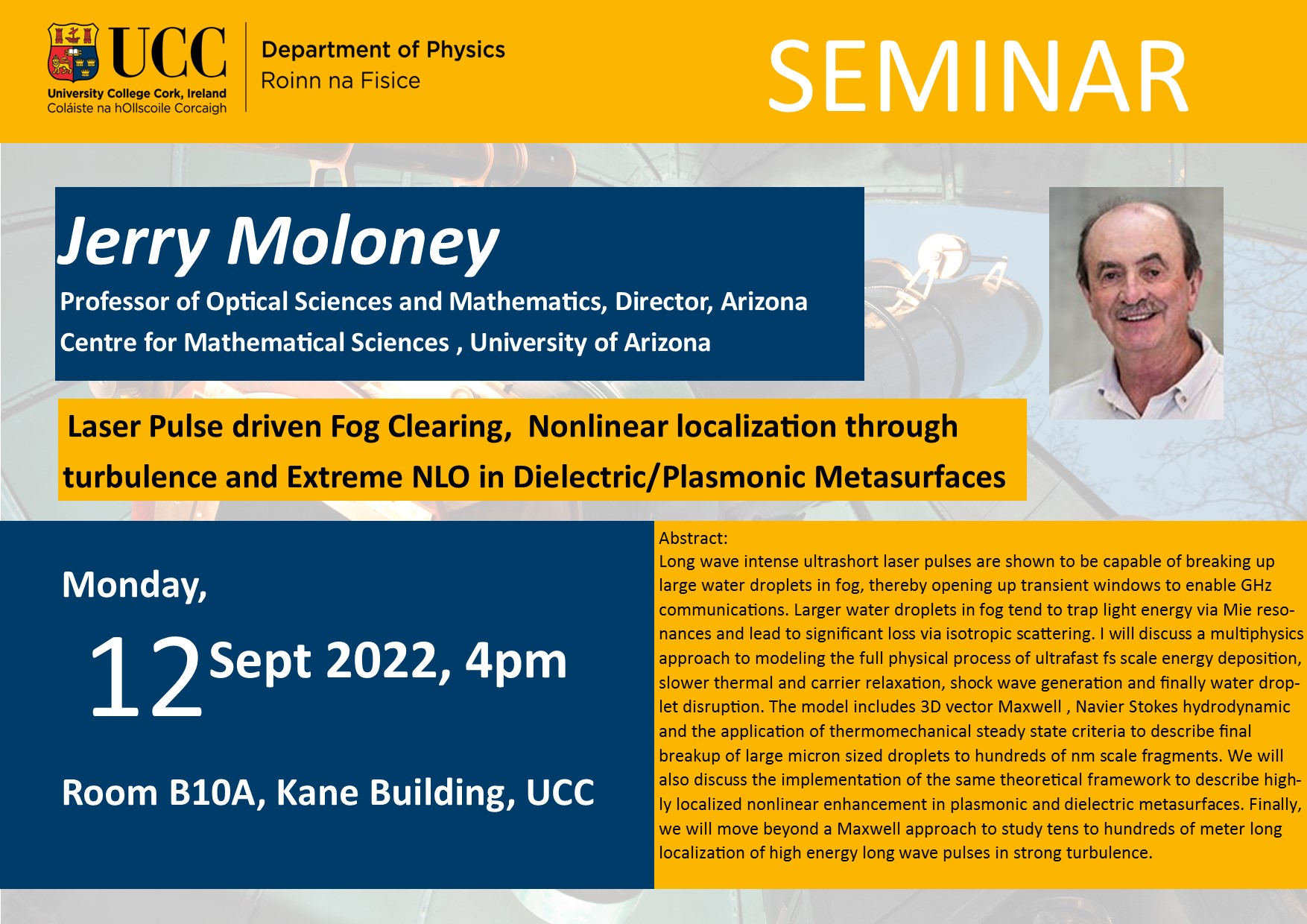
| Seminar Speaker: | Jerry Moloney |
|---|---|
| Venue: |
B10A, Kane Building, UCC |
| Time and Date: | Monday, 12th September, 2022, 4pm |
| Title: |
Laser Pulse driven Fog Clearing, Nonlinear localization through turbulence and Extreme NLO in Dielectric/Plasmonic Metasurfaces |
| Abstract: Long wave intense ultrashort laser pulses are shown to be capable of breaking up large water droplets in fog, thereby opening up transient windows to enable GHz communications. Larger water droplets in fog tend to trap light energy via Mie resonances and lead to significant loss via isotropic scattering. I will discuss a multiphysics approach to modeling the full physical process of ultrafast fs scale energy deposition, slower thermal and carrier relaxation, shock wave generation and finally water droplet disruption. The model includes 3D vector Maxwell , Navier Stokes hydrodynamic and the application of thermomechanical steady state criteria to describe final breakup of large micron sized droplets to hundreds of nm scale fragments. We will also discuss the implementation of the same theoretical framework to describe highly localized nonlinear enhancement in plasmonic and dielectric metasurfaces. Finally, we will move beyond a Maxwell approach to study tens to hundreds of meter long localization of high energy long wave pulses in strong turbulence.
|
|---|
Upcoming Seminars (More Details Pending)
Upcoming Seminars (More Details Pending)
